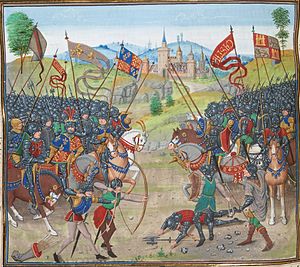Battle of Nájera

The battle of Nájera according to Froissart. Left John of Gaunt , Edward of Woodstock and Peter the Cruel , right Heinrich von Trastamara and the French
| date | April 3, 1367 |
|---|---|
| place | at Nájera |
| output | Victory of the English |
| Parties to the conflict | |
|---|---|
|
|
|
| Commander | |
| Troop strength | |
| 24,000 men | 60,000 men |
| losses | |
|
unknown |
15,000 men |
Chevauchées of the 1340s: Saint-Omer - Auberoche
Edward III. Campaign (1346/47): Caen - Blanchetaque - Crécy - Calais
War of the Breton Succession (1341–1364) : Champtoceaux - Brest - Morlaix - Saint-Pol-de-Léon - La Roche-Derrien - Tournament of Thirty - Mauron - Auray
France's allies : Neville's Cross - Les Espagnols sur Mer - Brignais
Chevauchées of the 1350s: Poitiers
Castilian Civil War & War of the Two Peter (1351–1375): Barcelona - Araviana - Nájera - Montiel
French counter-offensive: La Rochelle - Gravesend
Wars between Portugal and Castile (1369– 1385): Lisbon - Saltés - Lisbon - Aljubarrota
Battle for Northern France: Rouen - Baugé - Meaux - Cravant - La Brossinière - Verneuil
Jeanne d'Arc and the turn of the war: Orléans - Battle of the herring - Jargeau - Meung-sur-Loire - Beaugency - Patay - Compiegne - Gerberoy
The Battle of Nájera (sometimes called the Battle of Navarrete ) took place on April 3, 1367 near Nájera in what is now the autonomous region of La Rioja . It is a conflict during the First Castilian Civil War . However, it also became part of the Hundred Years War because England and France were aware of Castile's mighty fleet and wanted to prevent the other side from using it accordingly, which would have had a negative effect on the attacked side.
After the Treaty of Libourne , signed by Peter the Cruel of Castile , Charles the Evil of Navarre and Edward of Woodstock on September 23, 1366, the latter invaded Castile with his army , certain of victory over the Franco-Castilian To carry off opponents.
On their side, Bertrand du Guesclin had gained experience of how to get rid of the Black Prince due to several victories , but Heinrich von Trastamara did not want to take his advice: while Du Guesclin relied on tactics of attrition, Heinrich wanted to achieve victory in a single battle. However, he also had 60,000 men, while the enemy only had 24,000 available.
Du Guesclin advised against the open battle in advance, since he correctly assessed the tactical perfection of the English troops under the strategist Sir John Chandos . Taking into account the strategic unreliability of the thrown together troops of Henry II, he proposed instead to hide in the mountains, block the passes and thus block the way for the English advance. Heinrich ignored this proposal and led his troops into disaster.
The battle
On April 3, 1367, the battle broke out, which became a complete defeat for the French and Castilians under the command of Tello Alfonso of Castile , when at the height of the fighting one of the wings of Henry's army suddenly laid down its arms, whether out of cowardice or as treason, has not yet been clarified. Tello's losses amounted to 15,000 soldiers killed, wounded or captured.
The last battalion to oppose the English was Du Guesclin's unit. Through his long-lasting resistance, this also covered the retreat of Henry II, who thus escaped the slaughter alive, and then went, after his battalion collapsed under the numerical superiority of the English, into the captivity of Sir John Chandos. Later Du Guesclin was ransomed once more by Charles V of France .
Aftermath
Henry's defeat resulted in Peter the Cruel regaining the Castilian throne, but it wasn't decisive in the end. Heinrich and Du Guesclin succeeded in resuming the fight and pushing Peter back to Toledo , where Heinrich killed him by hand in 1369 after the Battle of Montiel .
literature
- Georges Bordonove : Les Rois qui ont fait la France. Les Valois. Volume 1: Charles V. Le Sage. Éditions Pygmalion Watelet, Paris 1985, ISBN 2-85704-185-3 .